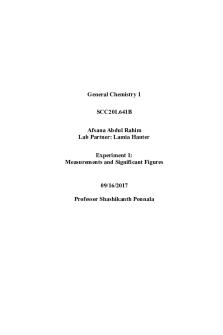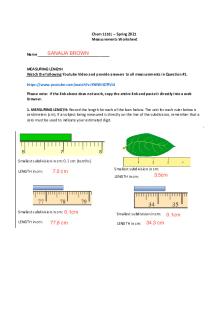Chemistry Lab 1 Measurements PDF

| Title | Chemistry Lab 1 Measurements |
|---|---|
| Author | Cherish Travis |
| Course | Principles Of Chemistry I |
| Institution | Augusta University |
| Pages | 5 |
| File Size | 117.3 KB |
| File Type | |
| Total Downloads | 4 |
| Total Views | 158 |
Summary
Lab Measurements for lab...
Description
MEASUREMENTS AND CALCULATIONS OBJECTIVES 1. To use and read graduated cylinders and balances 2. To express results of measurement and calculations with the correct numbers of significant figures 3. To express numbers using scientific notation 4. To do simple calculations involving percentage 5. To apply all concepts learned today to future experiments INTRODUCTION Part I. Measurements and significant figures In all sciences, measurements are important. The most fundamental properties that can be measured are length, mass, and time. The form that is usually used in chemistry is known as the CGS system, where the basic units of length, mass, and time are the centimeter, gram, and second, respectively. Thus, a measurement has unit. With a few exceptions, a number without unit is meaningless. This laboratory exercise has been designed to acquaint you with several types of measurement and measuring devices. When using any measuring device, you should always estimate and record data to one digit beyond the smallest graduation on the measuring device. Your estimate has significance and to ignore it is to overlook a useful digit that may be important in the analysis of results. For example, when reading a volume of water in a container such as a graduated cylinder, you will notice that the water is higher at the edges than in the middle. This phenomenon is called a meniscus. Always read the lowest point of the meniscus. Confirm in your mind that the two values below are 24.0 mL and 16.6 mL, respectively (Figure 1.1). 30
19
25
18
20
17
15
16
10
15
5
14
Figure 1.1 Taking volume measurement with a graduated cylinder.
In these measurements, there are 3 significant figures. The two underlined digits are read directly from graduations on the cylinder and are known with certainty to be correct. The last digit is estimated because of its uncertainty, but it provides useful information. Thus, significant figures are the numbers representing the part of the measurement that is certain, plus one number representing an estimate. The maximum number of significant figures possible in a measurement is determined by the measuring device. Significant figures must follow the measurement through all mathematical operations. Refer to textbook for specific rules concerning significant figures during mathematical operations. Example: The density of an object is defined as the ratio of its mass divided by the volume of that object. Suppose a piece of metal has a mass of 13.027 g and a volume of 8.10 mL, then its density is: Density = Mass Volume
(1)
Density = 13.027 g (5 sig. fig) = 1.61 g/mL (3 sig.fig.) 8.10 mL (3 sig.fig.)
(2)
Part II. Scientific notation It is very common to encounter very small or very large numbers. To be able to conveniently represent and work with these numbers and to avoid the confusion of significant figures in writing such numbers, scientists usually express very small or very large numbers in scientific notation. In this notation method, numbers are represented as the product of a nonexponential term and an exponential term in the form of M x 10n. The nonexponential term M is a number between 1 and 10 written with a decimal point to the right of the first nonzero digit in the number. The exponential term is a 10 raised to a whole number exponent n that may be negative or positive. A negative exponent means that the number is a small number (i.e. a fraction). A positive exponent indicates a large number. It should be noted that only the digits of the nonexponential term are significant. Example: 12.0 g of carbon contains 602,213,700,000,000,000,000,000 atoms. Writing this large number with 3 significant figures will be 6.02 x 1023 atoms. Part III. Percent The word percent literally means per one hundred. It is the number of specific items in a group of 100 such items. Since items are seldom found in groups of exactly 100, we usually have to calculate the number of specific items that would be in the group if it did contain exactly 100. Percent = number of specific item x 100 = total items in the group
%
=
Part x 100 = Total
(3)
(4)
MEASUREMENTS AND CALCULATIONS LABORATORY REPORT
NAME: __________________________ DATE: __________________________
Part I. Measurements and significant figures A. Expressing answers with the correct number of significant figures Perform the following operations and express the answer to the correct number of significant figures. Assume all numbers are the results of measurements. 9.006 + 107 + 0.0048 =
43.0 + 6.9028 + 0.040 =
4.748 g + 10.239 g =
37.78 mL x 0.362 g/mL =
21.405 g - 0.013 g =
7.12 mL - 0.05 mL =
(3.93)(12.10) = 2.00467
(107.13)(0.0801) = 5.278
(2.48)(0.036) = 1.783
(0.0602)(1.04) = 3.478
(43.94 + 39.20) = (6.23 - 1.79)
2.03 x 3.40 = (5.00 - 3.2)
(0.09121)(3.22) = (0.18 + 0.0153) B. Measurements using metric system 1. Obtain a rectangular glass prism and measure the sides (length, width, and depth) of the prism to the nearest 0.02 centimeter using a ruler. Determine the volume of the prism and express the answer with the correct unit and significant figures. Length =
Width =
Depth =
Volume of the prism = __________________
2. Weigh to the nearest 0.001 g the prism used in #1 above on the balance. Add about 50 mL of water into a graduated cylinder. Read the initial volume to the nearest 0.2 mL. Gently slide and drop the prism down the side of the cylinder containing water. Read the final volume on the cylinder. Calculate the ratio of mass/volume displaced to the correct significant figures and with the appropriate unit. Mass of prism
____________________
Final volume reading of cylinder
____________________
Initial volume reading of cylinder
____________________
Volume of water displaced by the prism
____________________
Ratio Mass/ Volume displaced
____________________
Question. Compare the volume of the prism obtained in #1 and the volume of water displaced obtained in #2. Comment on any similarities or differences.
Part II. Scientific notation Perform the following operations and express the answer using scientific notation with the correct number of significant figures.
(78.2 x 102)(2.0 x 103) =
(0.09020 x 104)(0.107 x 102) =
(5.3 x 105)(1079 x 10-2) =
(7.2 x 10-3)(1.002 x 104) = 2.10 x 10-2
(0.0240 x 107)(3.562 x 10-5) = (4.01 x 10-2)(1.007 x 104)
Part III. Percent 1.
In a fruit basket, there are 24 apples, 18 oranges, and 7 bananas. What is the percent of each fruit in the basket? Show your work. % apples =
2.
% oranges =
% bananas =
The human body is 70.0% water by mass. What is the mass of water in a person who weighs 85.7 kg?...
Similar Free PDFs

Chemistry Lab 1 Measurements
- 5 Pages

Chemistry Lab Report 1
- 4 Pages

Organic Chemistry Lab 1
- 14 Pages

Organic Chemistry Lab 1
- 5 Pages

Chemistry Pre lab 1 - Pre Lab 1
- 3 Pages

Lab 1- Measurements - PHY 207-lab1
- 10 Pages

General Chemistry Lab Report 1
- 10 Pages
Popular Institutions
- Tinajero National High School - Annex
- Politeknik Caltex Riau
- Yokohama City University
- SGT University
- University of Al-Qadisiyah
- Divine Word College of Vigan
- Techniek College Rotterdam
- Universidade de Santiago
- Universiti Teknologi MARA Cawangan Johor Kampus Pasir Gudang
- Poltekkes Kemenkes Yogyakarta
- Baguio City National High School
- Colegio san marcos
- preparatoria uno
- Centro de Bachillerato Tecnológico Industrial y de Servicios No. 107
- Dalian Maritime University
- Quang Trung Secondary School
- Colegio Tecnológico en Informática
- Corporación Regional de Educación Superior
- Grupo CEDVA
- Dar Al Uloom University
- Centro de Estudios Preuniversitarios de la Universidad Nacional de Ingeniería
- 上智大学
- Aakash International School, Nuna Majara
- San Felipe Neri Catholic School
- Kang Chiao International School - New Taipei City
- Misamis Occidental National High School
- Institución Educativa Escuela Normal Juan Ladrilleros
- Kolehiyo ng Pantukan
- Batanes State College
- Instituto Continental
- Sekolah Menengah Kejuruan Kesehatan Kaltara (Tarakan)
- Colegio de La Inmaculada Concepcion - Cebu








